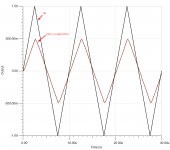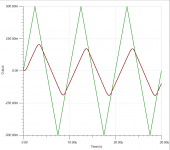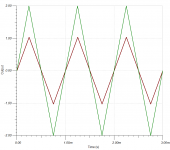The first one is, for me, probably more inciting to hear and understand, but not to buy.Just to be practical, set of measurements.
Would you buy this amp without audition?
But, do you have something like this (1st ist MT or HT: 8Ohm/700uH at 100KHz, 2nd and 3rd are Woofer or TT: 8Ohm/2700uH at 100KHz and 1KHz respectively)? Would these results incite to listening?
Sorry, measurements not at home, only the simulations. But measurements I confirm were identical to simulations.
The noise was all time <1mV.
Topology: balanced class A with global feedback + secret sauce
Technology: mixed IC + FET-based
PS: +/-40V (successful prototype) but dropped interest because I did not have time to go to +/-80V or +/-120V.
Box: not made yet, since project is dropped (will do it when at least +/-80V version is available) to reach target power 60W or 160W.
Attachments
Last edited:
The first one is, for me, probably more inciting to hear and understand, but not to buy.
Not my measurements, they are from a diy audio magazine.
Finally the listening impressions of the reviewers.
Let me call the first amp as A and the second one as B.
The first song we played was by a great vocal artist, Pat Benatar. The sound from this four-time Grammy Award winner belonged to 1940s music hall, assisting a big band concert. With the B there’s no listening fatigue, but with the A the music becomes warmer and sounds more bluesy. We changed CDs to listen to Joe Satriani, in a song (Down, Down, Down) full of intensity where Satch’s Ibanez guitar seems to be crying.
Definitely both amplifiers played this music very well, transmitting beautiful sensations; however, the B put too much emphasis on the cymbals, in our opinion.
Another great guitarist, Ted Nugent, played a song written for his lifelong friend Fred Bear: a fantastic song with the Detroit artist playing a great long solo with his Gibson Byrdland. Both amplifiers returned the right band dislocation, and the palm muting sounded very realistic.
We next played songs to emphasize voices. The scenic representation was similar when we played the gospel choir of Livingston Taylor, placing the A and the B on the same level. Robert Plant started to sing the apocalyptic Morning Dew, and we closed our eyes to let us fly with the song crescendo, where rock and Indian sonorities melted together. It was difficult to find differences between the two contenders, because both returned a natural and rich sound. The same happened when we turned on the turntable to play the first studio record of Patti Smith, with that superb remake of Van Morrison’s Gloria. Instead, when letting Sara K. sing, we noticed that the scene moved back with the A.
When doing all this listening, we found important to see what happens when playing a live concert recording, and to accomplish it the stylus touched the grooves of Cheap Trick at Budokan (a remastered version, including the concert video, is now available on CD). Need your love it's a blues-rock song, with the rhythmic always in evidence and Zander voice transmitting all the song lovehate binomial, while Nielsen's Hamer Explorer glues the parts to end up with an enthralling solo. The B returned a deeper stereo image, with the fans crying more in evidence in the background, which caused some disappointment. Instead the A excelled when reproducing Petterson's eight string bass, as well as the total timbre balance and the details. We were almost capable to see Rick throwing to the crowd his picks: OK, OK our imagination was traveling too fast!
It's time now for Valery Gergiev to start conducting The Nutcracker: both the amplifiers were able to show us the orchestra, with every instrument in the right place of the stage. The characteristic brass in the Intrada was well suited under the strings, a little higher, better focalized with the A, which played very well the beautiful timbre of brass. We also felt a better control in the bass region (timpani at the end of the Intrada) with the A. The scenic reconstruction was deep and large in both the amplifiers.
Let's resume the characteristics of the two.
A: well controlled, especially in the bass region, and good contrast; beautiful timbre, well balanced, and good precision in the scenic presentation. A perfect mix.
B: a bit less controlled than the A (but we feel that this is a peculiar characteristic of the A) but with more dynamic. This leads to have more punch, a better sense of rhythm, and so a more intense involvement with pop, rock and electronic genres. The only drawback is some lack of grain, with certain recordings, in the high frequencies region.
Do listening impressions confirm the measurements?
Let's resume the characteristics of the two.
A: well controlled, especially in the bass region, and good contrast; beautiful timbre, well balanced, and good precision in the scenic presentation. A perfect mix.
B: a bit less controlled than the A (but we feel that this is a peculiar characteristic of the A) but with more dynamic. This leads to have more punch, a better sense of rhythm, and so a more intense involvement with pop, rock and electronic genres. The only drawback is some lack of grain, with certain recordings, in the high frequencies region.
Do listening impressions confirm the measurements?
No. And your point is...?
Based on the measurements, I would not bother listening to any of these two amps. They many times worse than what I would like to see. Plus many other measurement not shown (and some construction details).
Last edited:
Understood. If one thinks about reproducing exact signal amplitude at a precise point in time, it obviously can't be done to 50-bits of accuracy. However, if humans can hear the difference between 50-bits of processing verses 32-bits then there must be reason.
IMHO, the reason is in the Math, or in the understanding of how the process is actually happening. In this case I disagree with Scott.
The -300dB (or 50-bit) noise level is in the digital domain. Once the processing is done, what you have is a high resolution digital data (24-bit word NOT a 1-bit pulse train with digital noise and NOT a 50-bit word either). It doesn't matter if the DAC you use to convert that high resolution digital data to analog is only 24-bit.
The 50-bit is only temporary in the digital processing.
Yes, apparently they did in my case.Not my measurements, they are from a diy audio magazine.
...
Do listening impressions confirm the measurements?
But there is a lot of room for improvement.
The A has a slight current source behavior at bass, which gives control and warmth.
The B is slightly more fast and transparent.
Both are not bad at IMD, quite enough quality.
Still no buy, but maintain interest to hear A more than B
I hope my interpretations prove right compared to reality inside them.
Do listening impressions confirm the measurements?
What can anyone guess from the plots I gave above? I am really curious.
Or too much high fidelity, too raw and flat...?
This was interesting
Thanks, Andrea
Do listening impressions confirm the measurements?
Mostly yes. Most of the important quality can be seen from the FFT. The first one is the noise floor. Most of the good quality is due to this. Second one is the harmonics spectrum (which also tell you the lack of bias current in both amps especially A). More spikes above 10k with most low biased amps produce fatigue.
There is the fault of the source that can make wrong conclusion. An accurate amp should show errors when the errors are within the recording). Sara K is usually produced by high quality record production like Chesky where they use simple mic recording and little processing (so the room reverberation is real).
The amount of bias current required in some amplifiers is much less than you might think. Still others require silly amounts of bias current to make the output stage linear. Above the required amount of bias current, all you do is increase supply noise, and create large amounts of heat. That reduces reliability and increases your power bill unnecessarily.
-Chris
-Chris
PCB for measurement setup has arrived. Just had time to solder STM32 on it and blink a LED, that's a start lol.
What topologies?
The amount of bias current required in some amplifiers is much less than you might think. Still others require silly amounts of bias current to make the output stage linear.
What topologies?
You have no idea about what you are talking about.
Hi Peufeu,
Great! PCB for measurement set = time to play!
Even with similar typologies, the required bias currents can very a huge amount. One amplifier might be fine at 5 mA while another similar one needed 250 mA. So it is very difficult to arrive at a bias figure by looking at a schematic - although that can give you a pretty good clue sometimes.
That amp that needed 250 mA? Factory bias was 25 mA, it was left at 60 mA to get rid of the worst of it. I was surprised it took so much. I will not name the make and model. Its an otherwise good amplifier. More suited to pro amp use, but people use them in their systems.
-Chris
Hi Peufeu,
Great! PCB for measurement set = time to play!
Even with similar typologies, the required bias currents can very a huge amount. One amplifier might be fine at 5 mA while another similar one needed 250 mA. So it is very difficult to arrive at a bias figure by looking at a schematic - although that can give you a pretty good clue sometimes.
That amp that needed 250 mA? Factory bias was 25 mA, it was left at 60 mA to get rid of the worst of it. I was surprised it took so much. I will not name the make and model. Its an otherwise good amplifier. More suited to pro amp use, but people use them in their systems.
-Chris
Just to be practical, set of measurements.
Would you buy this amp without audition?
No. I can design it better
The amount of bias current required in some amplifiers is much less than you might think. Still others require silly amounts of bias current to make the output stage linear. Above the required amount of bias current, all you do is increase supply noise, and create large amounts of heat. That reduces reliability and increases your power bill unnecessarily.
I love CFP. In CFP we have to balance the crossover distortion with other issues. Lower output bias will ensure low crossover distortion. But still there's price to pay sound-wise.
In most amplifiers (especially not CFP), increasing output bias will increase general performance. Sometimes it increases portion of the power running in class A. So, for "operation" current needed may be low, but for "better sound" that's against people preference.
Even with CFP many people prefer the high current setting. For me, I can hear the difference so I understand whichever people prefer.
That isn't true.In most amplifiers (especially not CFP), increasing output bias will increase general performance.
That isn’t always true.
That's what the "most" is for
I have mentioned that at the top of my hearing threshold is my sensitivity to fatigue. I just found that class-A is more fatigue free. I have tried hard to make my class-B have the same "trait" but not yet fully successful...
I have make the power supply to be able to instantly deliver current like in class-A. I have tried to mask the high order harmonics with lower order ones. I think the key is in burrying the high order harmonics under noise, but low noise amps sound better...
So if you have some tricks to remove the high order harmonics with low bias without sacrificing noise floor, I hope you can share for free
Hi johnego,
That statement isn't really true all the time either. "Class A" done right also has it's distortion and problems.
As far as the speed of delivering current, what you stated is also not true at all. Too many generalizations being made that have zero basis in fact. I accept that you like the "sound of class A", whatever that is. I think its more the idea and lore surrounding class A circuits that has you enamored. But you believe it and for you that is all that matters.
That statement isn't really true all the time either. "Class A" done right also has it's distortion and problems.
As far as the speed of delivering current, what you stated is also not true at all. Too many generalizations being made that have zero basis in fact. I accept that you like the "sound of class A", whatever that is. I think its more the idea and lore surrounding class A circuits that has you enamored. But you believe it and for you that is all that matters.
- Status
- Not open for further replies.
- Home
- Member Areas
- The Lounge
- Sound Quality Vs. Measurements


